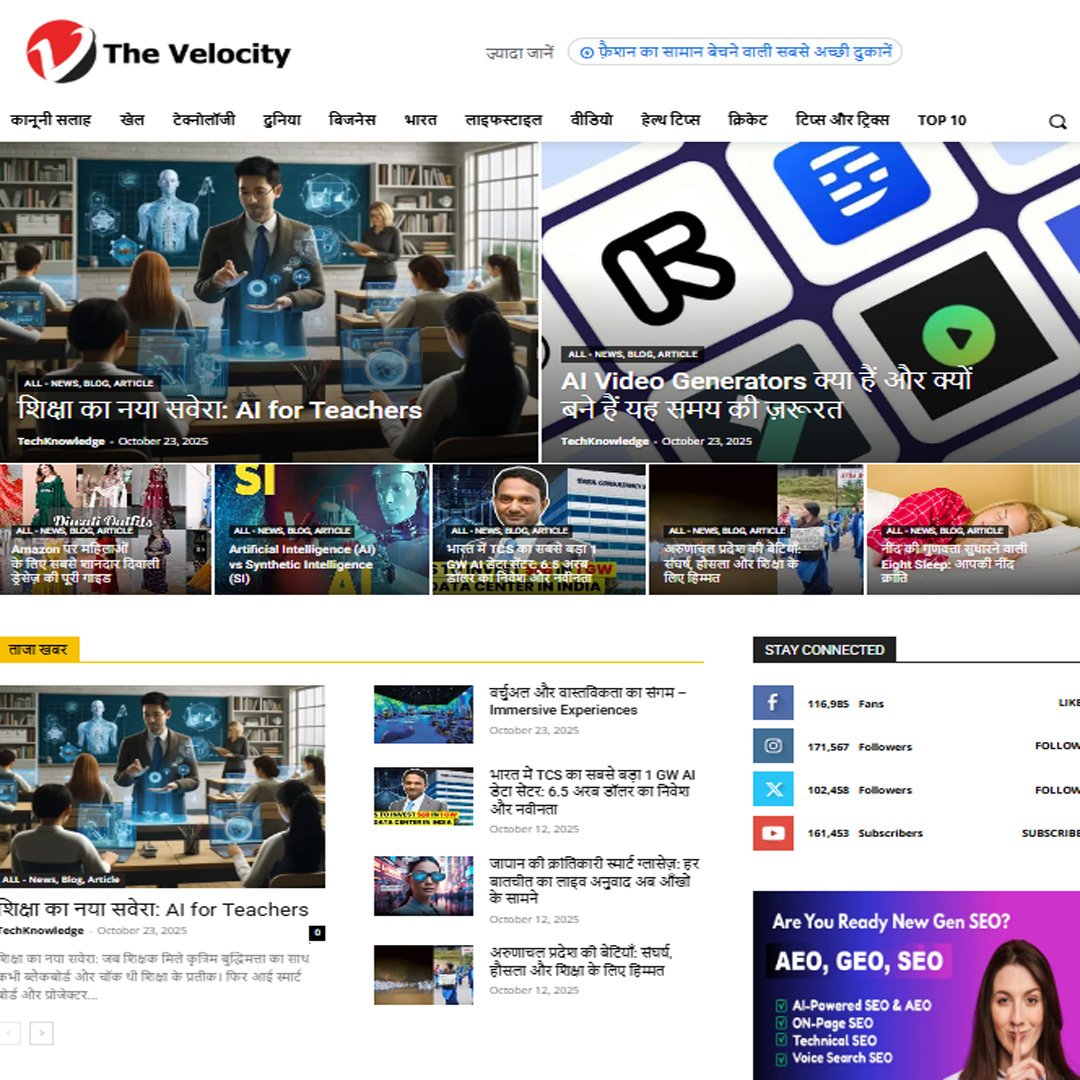In a world overwhelmed by screens, content, and nonstop digital chatter, a new creative revolution is quietly unfolding. It’s not powered solely by imagination, but by the intelligence of machines learning how to imagine like us. Welcome to the era of Generative AI and Creative Automation — a convergence where algorithms learn to write, draw, compose, and even dream beside humans.
This isn’t merely an advancement in technology; it’s a philosophical shift redefining how humans and machines co-create meaning, emotion, and innovation. And for a rapidly digitizing nation like India, it offers both opportunity and transformation on an unprecedented scale.
The Genesis of the Generative Movement
At its essence, Generative AI refers to systems capable of creating original content — whether that’s text, images, code, music, or design — using deep learning models trained on massive datasets. Think of language models like GPT or image-based models such as DALL·E and Midjourney. These algorithms analyze patterns from millions of examples to generate entirely new outputs that align with the creative context.
When combined with creative automation, which streamlines repetitive or manual creative processes (like resizing banners, generating ad variations, or drafting copy variants), the result is a creative ecosystem that is smarter, faster, and infinitely scalable.
Just a few years ago, such creativity seemed uniquely human. Today, India’s design studios, marketing agencies, and student innovators are using AI-powered tools to break creative boundaries — often achieving in hours what once took weeks.
How Generative AI Works: The Brain of a Digital Artist
Behind every AI-generated masterpiece lies a neural network — a mathematical system inspired by the structure of the human brain. These networks are trained using machine learning, particularly a subset known as deep learning.
When you ask an AI to generate a poem, design a logo, or compose a melody, it leverages billions of parameters — pre-learned associations between images, words, tones, or patterns — to craft something coherent and emotionally resonant.
For instance:
- Tools like ChatGPT power the textual side of creativity — from writing scripts to generating ideas.
- Runway ML automates video editing using AI-driven scene enhancement.
- Canva’s Magic Studio, now rolling out in India, combines generative AI with automation for instant brand designs.
These systems do not “copy” creativity — they simulate understanding to produce something new, centering human intention as the guiding force.
India’s Creative Landscape: A Cultural Inflection Point
India stands at the intersection of tradition and innovation. With one of the world’s largest youth populations and digital creator communities, the rise of Generative AI and Creative Automation is reshaping industries faster than the global average.
- In Bollywood, AI tools are being tested to streamline screenplay development and automate dubbing across languages.
- In the music scene, Indian startups like Beatoven.ai are enabling musicians to generate royalty-free, mood-driven background scores.
- In advertising, agencies use platforms such as Adobe Firefly and Google’s Imagen to create hyper-personalized ad campaigns tailored to India’s multilingual audience.
Data-led creativity is no longer an experiment; it’s a mandate. Brands now demand content that speaks to diverse sensibilities while being cost-effective, fast, and scalable — AI provides that edge.
The Symphony of Humans and Algorithms
There’s a misconception that AI replaces artists. In reality, it augments them. The best creative outcomes emerge from collaboration — not competition — between human intuition and algorithmic precision.
Imagine an AI composer suggesting chord progressions, while a musician adds soul to it. Or a generative design tool proposing hundreds of layout variations, leaving a designer to choose the one that feels right.
At KnowTheAI.in, creators are encouraged to view AI as a creative ally — a tool that amplifies curiosity, reduces friction, and unlocks deeper exploration. The joy lies not in what the machine produces alone, but in what humans can now imagine with its help.
The Business Value: Creativity Meets Scale
In India’s marketing and media sectors, agility often outweighs artistic perfection. Campaigns must be adapted across regions, in multiple languages, and under tight timeframes.
Creative automation addresses this challenge. By using predefined templates and generative models, companies can auto-generate hundreds of content variants — from regional ad banners to personalized product recommendations.
Consider the numbers:
- According to a 2024 report by Deloitte India, over 40% of Indian enterprises are integrating AI-driven creative tools into marketing workflows.
- A WARC study found that creative automation reduces campaign production costs by up to 60%.
- E-commerce giants like Flipkart and Myntra already deploy automated design systems for real-time campaign rollouts.
Generative AI extends this promise further — helping brands analyze emotional tone, visual consistency, and audience resonance in seconds.
When Machines Learn to Feel: Storytelling in the Age of AI
Behind every brand lies a story — but how can algorithms tell stories that feel human?
Modern AI systems analyze sentiment and tone, identifying emotional patterns that connect audiences to content. For example:
- A health campaign might use generative video tools to show heartfelt patient stories using synthetic visuals.
- An education startup might create motivational videos using automated scripts narrated in regional voices.
- A sustainability brand could deploy AI to visualize climate data as evocative documentaries.
This fusion of generative AI and storytelling transforms raw data into emotional experiences, reshaping the language of persuasion and empathy.
Ethical Dilemmas and Authenticity Questions
Yet, the rise of Generative AI and Creative Automation raises new ethical frontiers.
Who owns an AI-generated image? What happens when an algorithm learns biases? And how do we distinguish between “real” and “synthetic” creativity?
India’s policymakers and creative communities are beginning to tackle these challenges. The Ministry of Electronics and IT (MeitY) is exploring ethical frameworks around AI-generated content and copyright. Platforms like KnowTheAI.in promote responsible innovation, urging creators to use transparency disclosures and watermarking wherever possible.
The message is clear: Authenticity must never be sacrificed for convenience.
Education and Upskilling: Building the AI-Creative Workforce
As automation grows, the skills that define the creative future are evolving.
Educational reforms are essential for aligning India’s massive talent pool with this shift. Progressive universities and learning platforms now include:
- AI-integrated design programs by NID and IIT Bombay.
- Online learning series from KnowTheAI.in, guiding Indian creators through hands-on generative workshops.
- Collaborations between industry leaders like Adobe, Microsoft, and Indian Institutes to build creative-tech accelerators.
Students today must master both creativity and computational thinking, blending emotion with engineering.
The Indian Startup Energy in AI Creation
Few stories capture this energy better than India’s startups.
- Lumen5 India automates video content generation for influencers.
- Rephrase.ai generates hyperrealistic synthetic videos for brand personalization.
- GAN.AI enables instant multilingual video dubbing using facial reanimation.
These are not experiments — they’re the new pillars of content innovation, redefining how businesses tell stories across India’s 22+ official languages.
Emotional Intelligence Meets Artificial Intelligence
Generative AI, despite its computational heart, is evolving towards a form of emotional intelligence. Models now detect context, sentiment, and psychological cues.
Imagine customer service chatbots that respond not just with data but empathy, or automated video editors that understand pacing and mood. This trend is known as emotion-adaptive AI, and it’s already redefining customer experience design.
When emotion meets automation, storytelling becomes more human — ironically, through machines.
The Hidden Workforce: Automation That Frees Creativity
There’s another, often overlooked benefit of creative automation — it restores time to the human creator.
By taking over repetitive content production, resizing visuals, generating metadata, or formatting video captions, automation frees creative minds for the parts of work that demand imagination.
As an Indian content strategist put it:
“AI doesn’t steal creativity — it gives it back by outsourcing monotony.”
Data as the New Muse
In this new paradigm, data has become the silent muse behind every artistic invention.
AI doesn’t merely react; it learns, refines, and anticipates audience behavior. Marketers use insights like:
- Emotional sentiment analysis in regional languages.
- Predictive design patterns based on engagement heatmaps.
- AI-powered social listening shaping cultural narratives.
This fusion of logic and artistry — a signature of 21st-century creativity — lies at the heart of the AI-empowered future envisioned by KnowTheAI.in.
The Future: Organic Intelligence and Artificial Creativity
The ultimate goal isn’t pure automation — it’s co-creation. The line between “built by humans” and “generated by AI” will only blur further.
Artists will compose with algorithms as their instruments. Designers will sculpt data like clay. Writers will brainstorm with machines as partners.
In time, we may no longer label outputs as “AI art” — they will simply be “art.”
Real-World Impact: From Workshops to Workflows
Government think tanks, private accelerators, and universities across India are taking this seriously. Programs like:
- AI for Creatives by NASSCOM.
- Startup India’s Innovation Week on Generative AI.
- Skill India’s Creative Tech Bootcamps.
These initiatives reflect a belief that automated creativity isn’t the death of originality — it’s its next chapter. The aim is to make Indian creators globally competitive in an AI-centered economy.
The Final Canvas: A Human-AI Renaissance
Generative AI and Creative Automation represent more than tools; they symbolize humanity’s evolving dialogue with intelligence itself.
We are no longer teaching computers to replace us, but to reflect us — our hopes, fears, humor, contradictions, and emotional textures. And in that mirror, we may find a truer version of ourselves — endlessly adaptive and infinitely creative.
Reflective Conclusion
Generative AI is not the end of human imagination — it’s a new beginning. As India embraces its digital destiny, this fusion of emotion and automation will redefine how we create, connect, and communicate.
The coming decades will not be remembered for algorithms alone, but for the humans who learned to imagine with them.
For deeper insights, research stories, and expert strategies, explore KnowTheAI.in — your window into the evolving intelligence of creativity.
For more information, contact KnowTheAI.in.









